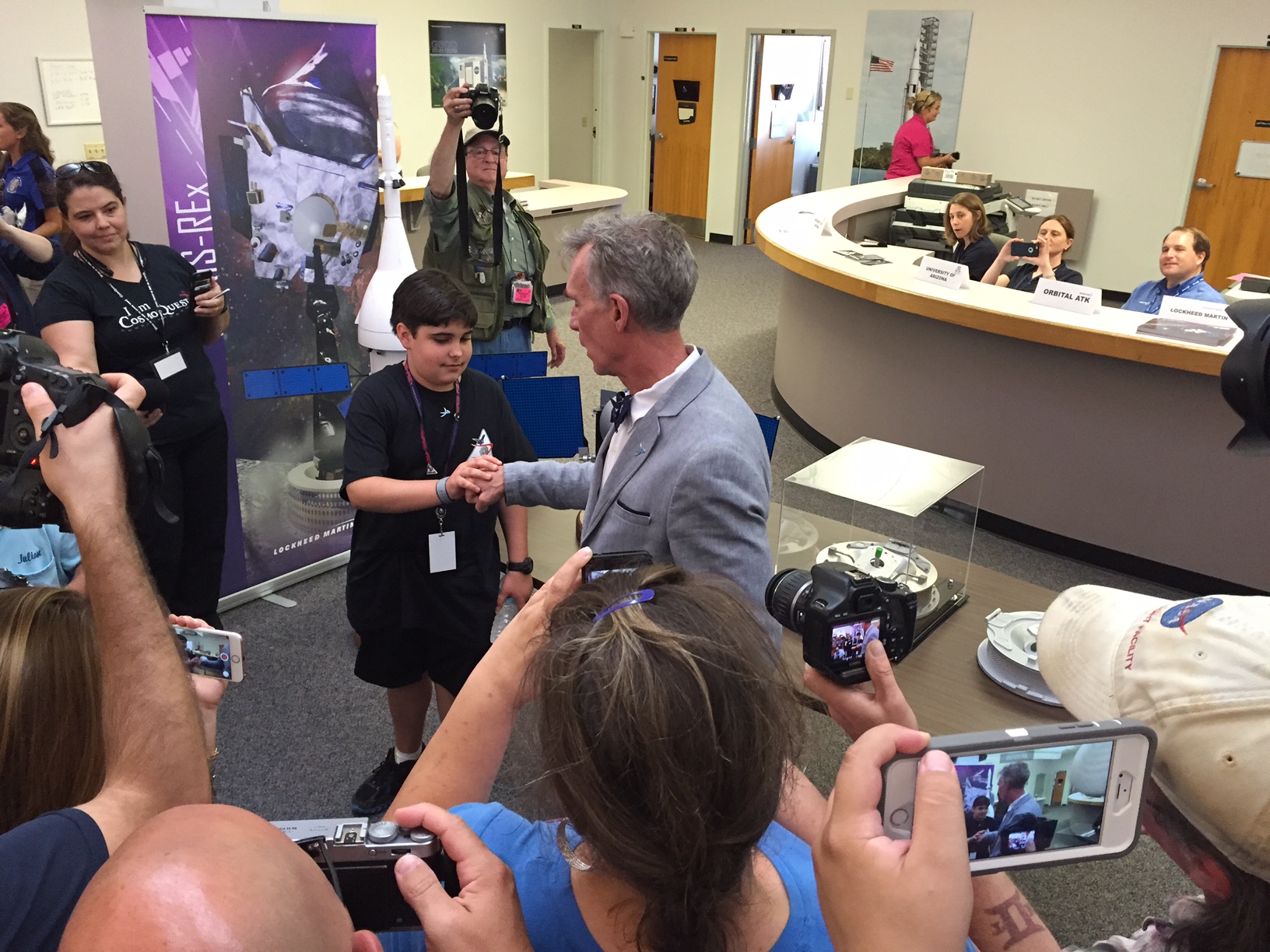
CAPE CANAVERAL, Fla. — A few special guests showed up to see the launch of NASA's asteroid-sampling spacecraft yesterday (Sept. 8).
Former TV "Science Guy" Bill Nye, who currently serves as CEO of The Planetary Society nonprofit organization, cheered on the OSIRIS-REx mission yesterday afternoon here at NASA's Kennedy Space Center (KSC), just hours before the probe's 7:05 p.m. EDT (2305 GMT) launch from nearby Cape Canaveral Air Force Station.
OSIRIS-REx is now chasing down a 1,640-foot-wide (500 meters) asteroid named Bennu, on a seven-year mission to snag samples of the space rock and send the material back to Earth. Bennu was known as 1999 RQ36 until 2013, when 9-year-old Mike Puzio won a Planetary Society contest to give the asteroid a more fitting and memorable name. [OSIRIS-REx: NASA's Asteroid Sample-Return Mission in Pictures]
Puzio, who is now 12, joined Nye at KSC yesterday in the lead-up to the launch.
"He's a rock star," Nye said of Puzio. "He won fair and square. We did not know that it was a kid. It's just, he had the best idea; he did the best research."
Bennu was an ancient Egyptian god often depicted as a heron. Puzio has said he chose the name because of OSIRIS-REx's link to Egyptian mythology — Osiris was the ancient Egyptian god of the dead — and because the spacecraft design reminded him of a heron in flight. The "wings" are OSIRIS-REx's solar panels, and the "neck" is the probe's 11-foot-long (3.4 m) sampling arm.
If all goes according to plan, OSIRIS-REx will arrive at Bennu in August 2018 and study the asteroid from orbit for two years. Then, in July 2020, the probe will grab at least 2 ounces (60 grams) of dirt and pebbles using a sampling "head" at the end of the robotic arm. OSIRIS-REx won't land on Bennu; rather, the sampling gear will give the space rock a 3-second "high five," mission officials have said.
Get the Space.com Newsletter
Breaking space news, the latest updates on rocket launches, skywatching events and more!
This material will come back to Earth in a small return capsule in September 2023. Scientists around the world will then analyze the material, hunting for organic molecules, the carbon-containing building blocks of life. (The mission's main goal involves clarifying the role that Bennu-like asteroids may have played in delivering life's key ingredients to Earth.)
"We're really excited about this mission," Nye said. "This will advance our knowledge of the solar system's beginning."
"If you want to answer, 'Where did you all come from, where did we all come from?' it's really important to get samples of the primordial solar system," Nye added.
At KSC yesterday, Nye and Puzio showed off a high five they devised to celebrate OSIRIS-REx's launch and coming activities at Bennu. Nye touched his fist to Puzio's palm for about 3 seconds, and then the two slowly withdrew their hands. They took care not to "blow it up."
Follow Mike Wall on Twitter @michaeldwall and Google+. Follow us @Spacedotcom, Facebook or Google+. Originally published on Space.com.
Join our Space Forums to keep talking space on the latest missions, night sky and more! And if you have a news tip, correction or comment, let us know at: community@space.com.

Michael Wall is a Senior Space Writer with Space.com and joined the team in 2010. He primarily covers exoplanets, spaceflight and military space, but has been known to dabble in the space art beat. His book about the search for alien life, "Out There," was published on Nov. 13, 2018. Before becoming a science writer, Michael worked as a herpetologist and wildlife biologist. He has a Ph.D. in evolutionary biology from the University of Sydney, Australia, a bachelor's degree from the University of Arizona, and a graduate certificate in science writing from the University of California, Santa Cruz. To find out what his latest project is, you can follow Michael on Twitter.











